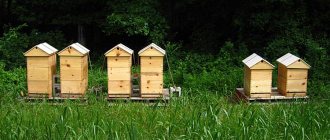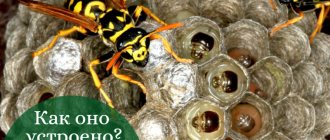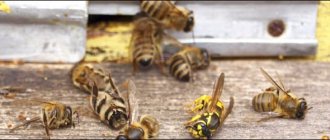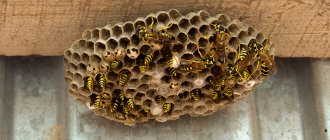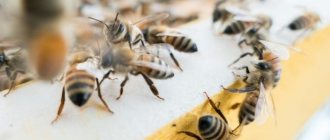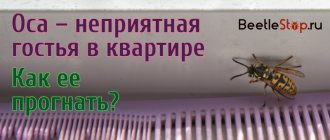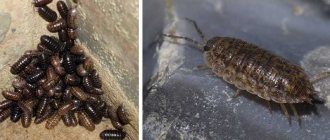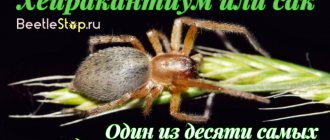Finding a nest of wasps or hornets in your dacha is unpleasant. But if stinging insects have chosen you as their neighbor, it doesn’t hurt to know what you can do about it.
Imagine the situation. You arrive at your dacha after a long absence. Inspect your property. And in one beautiful corner you discover a gray, terrifying cocoon - a nest of wasps or hornets. So that you are not tempted to open THIS and check what's inside, let's reveal a secret: inside are yellowish larvae, waiting in the wings. And also a whole squad of dissatisfied insects, ready to defend their “kindergarten” and uterus to the last drop of blood.
Wasp (and especially hornet) stings are not just unpleasant and painful. They can cause a severe allergic reaction. Therefore, we recommend that you immediately abandon the idea of peacefully coexisting with insects. Another reason to get rid of the nest as quickly as possible is that its inhabitants can infect plants in the garden or vegetable garden with mold or bacteria. We should not forget about the gluttony of wasps, as well as the constant buzzing and humming of winged creatures.
Where do wasps nest?
The young queen chooses a place where there is building material and food supplies in close proximity. In the wild, insects make their homes on trees with a large, dense crown, under old stumps, and abandoned bird houses. However, there are cases of a hive being built under a stone, on a blade of grass. Where the young female considers it necessary to build housing, the working individuals will continue the construction.
Insects can build hives near humans - under the roof of a house, outbuildings, in an attic, on a balcony, or live in a garden, yard, vegetable garden, or vineyard. And also on trees, bushes, old stumps on the site. If in the wild, wasps bring a lot of benefits, destroying harmful insects, in the territory of a garden, summer cottage, yard, they become real pests. Therefore, a person tries to get rid of wasp nests on a balcony, in a country house, or in a vineyard.
On a note!
It's very easy to anger a wasp. A few sharp movements are enough for her to rush to attack. During an attack, it makes special sounds - signals, warns other members of society about the danger, and also calls for help. If there is a nest nearby, a whole swarm can attack a person.
Various methods of destroying a nest
Option 1
You need to start fighting the dominance of hornets with the onset of cold weather (late autumn - early winter).
- Remove all old nests.
- Seal cracks and holes.
- Adjust the doors so that they close tightly.
- Continue activities in the spring, try to find a nest.
Attention! All pest control work is carried out in special protective clothing. It consists of a hat with a veil covering the face, neck, and head
A jumpsuit or jacket and pants are worn that completely cover all other parts of the body. Boots and gloves complete the outfit.
Option #2
Hornets' nest can be found in the basement
- Since April, experienced beekeepers begin to monitor the appearance of large, sexually mature females on the site. Having chosen a place, the queens begin to sculpt the first honeycombs. This is the moment that cannot be missed. You need to immediately, armed with a shovel and a puller, knock down a small cocoon the size of a walnut and crush it (or burn it) with all its contents.
- At dusk, treat the nest with foam from a carbon dioxide fire extinguisher so that all the honeycombs get wet and their inhabitants freeze. Then remove the house mechanically.
- If you find a nest in the area hanging from the branches, take a plastic bag (you can use it for garbage). Spread it just under the hanging house. Use tree pruning shears attached to a long pole or otherwise trim the cocoon. Immediately direct a stream of Dichlorvos, Executioner, Get or another insecticide against flying insects at it. Quickly tie the bag until the poisons evaporate, then burn.
Option #3
Nest in the attic - hidden in a hard to reach place
Don't know how to destroy a hornet nest in your attic or shed? Everything is simpler than it seems in reality:
- Hang a bucket full of boiling water or kerosene diluted in water under the roof. The container is suspended so that the cocoon is completely immersed in the solution. Support the bucket with a makeshift pedestal or stepladder. Wait a day. Remove the limp nest.
- Buy 2 or 3 cans of Karbofos, Dichlorvos, Executioner or another product that specifically affects flying insects (specifically hornets). From a safe distance, direct the jet at the structure and carefully treat the house. Then inject the insecticide inside through the bottom passage. Leave for a day. To enhance the effect, smoke the hornets that managed to fly out before treatment. Check for live specimens. If necessary, repeat the treatment. Get rid of the nest.
- You can seal the honeycombs with polyurethane foam.
- First spray the nest hanging from the branches with diesel fuel or gasoline from a spray bottle, then set it on fire.
- A discovered hornet nest in the ground is poured with boiling water. As an option, build a fire in this place or, after digging out the entrance, burn out the insects with a blowtorch.
- Also, kerosene or gasoline is poured into the “underground house” at night and then set on fire.
- Hornets that have settled in tree hollows are poisoned with an insecticide. Often, diluted poison against Colorado potato beetles is used for this. After this, the hole in the hollow is covered with cement mortar or putty.
If independent measures do not lead to effective results, you need to contact a pest control service. This should be done immediately if a child is bitten by a hornet.
Construction material
The finished wasp nest is nothing short of impressive. From the outside it looks like a smooth, oval-shaped egg. Inside, numerous honeycombs are found, arranged in a certain way. The building material resembles ancient parchment. Mostly gray, brownish in color. Because of the way wasps build their nests, they are called paper wasps. The family is one of the most numerous and includes species and subspecies.
What wasps make nests from and how building materials are obtained also deserves respect. The insect lands on wood, spits out a certain amount of its own secretion, under the influence of which the upper tissues of the tree bark liquefy. The wasp grabs the top layer with its powerful jaws and pulls it towards itself, as if scraping it off. When she has the amount she needs, she goes to a place where other relatives are making a hive.
Having arrived at the right place, the wasp once again carefully chews the building material with its jaws. Under the influence of saliva, the wood becomes sticky, stringy, gray or brown, depending on what tree it was extracted from. The wasp spits the finished building material onto the already formed honeycombs, again stretches it with its jaws, giving its structure an oval shape. This is how a new thin partition appears.
Interesting!
The wasp obtains woody elements from the bark of various trees, stumps, fences, and wooden outbuildings. If there is not enough building material or the queen finds a place suitable for raising larvae, the wasps build a nest underground, in old stumps, hollows, left by bird houses.
Nest construction
Wasps build their nest, as a rule, together, but the initial construction is always carried out by the female alone - the founder of the entire colony. She also feeds the first hatched larvae. These larvae subsequently grow into working individuals, which help the female in further construction.
Females begin to build a new nest in early spring, immediately after waking up from winter sleep. Having emerged from its hiding place, the founding wasp flies in search of a suitable place for the nest - it must be protected from wind, direct sunlight and prying eyes. They often choose a tree branch with a dense crown, an abandoned building, or the attic of a private house. Sometimes construction can even begin on the surface of a large stone, in an abandoned burrow of some rodent, in a rotten stump, in a hollow tree, or behind the siding of a residential building.
The first “brick” of a wasp’s nest is a thin thread of frozen sticky secretion, which the female attaches to the selected surface. Further, this thread gradually turns into a clearly visible “leg”, to which the first two cells are initially attached, and then the entire structure.
How does a wasp's nest expand?
The construction of a wasp's nest proceeds quite quickly. As soon as the “foundation” has been laid, the wasps immediately go for additional wood, with the help of which they begin to build up the cells. In this case, they take building material, as a rule, in close proximity to the construction site itself, leaving behind characteristic grooves on the surface of the boards or bark. Using its jaws and legs, the wasp makes thin paper plates, attaches them to the base of the nest and flies for the next portion of material.
A wasp's nest grows as follows:
- more and more new cells appear at the base of the handle, which overlap each other and form a honeycomb;
- as the number of honeycombs increases, the shape of the future nest begins to be visible - at first it is a kind of bowl;
- over time, the bowl becomes wider and deeper and, as a result, transforms into a sphere, in the lower part of which an inlet hole remains;
- then the wasps begin to build a second sphere, which wraps around the first - thus, the nest increases in size;
- when the construction of the second sphere is completed, the female removes a certain number of cells located on the first sphere - the inner one, and the more shells are built up, the more cells are destroyed inside the nest.
As a result, the structure of a wasp's nest turns out to be quite funny: the honeycombs are arranged horizontally - in floors, while the cells look only down.
The inside of the nest will always be the strongest and safest, and therefore it is there that the queen herself and the honeycombs in which the larvae develop are located. To build this zone, insects use wood chips rather than thin paper material. Their maximum size is the one that wasps are able to carry and attach.
The outer shell of a wasp nest is much less durable, since it consists of the thinnest, longest and most elastic paper plates. Moreover, wasps often use recycled raw materials for the construction of the outer skin, which they take from the internal destroyed layers.
The design of the wasp nest is thought out to the smallest detail. Multi-storey honeycombs create a special atmosphere inside the building: almost constant temperature and air humidity are maintained there all the time.
Construction process
A fertilized young female, the queen, chooses a place for her future home. It glues an adhesive substance extracted from wood to the base, stretches it, and a leg is formed, on which the first honeycombs are subsequently built. Initially there are very few of them; they are necessary for growing and feeding the larvae.
The process begins in early spring. Within a month, a new generation of worker wasps appears and begins active construction of the hive. The uterus sheds the powers of an architect and is engaged only in the reproduction of offspring.
- The hornet's nest is being built at an accelerated pace, since the number of members of the large family is rapidly increasing. New cells appear at the base of the handle, which overlap each other to form a honeycomb.
- As the number of cells increases, a bowl-shaped structure begins to emerge. Over time, it increases in depth, expands on all sides, and becomes like a sphere. There is a hole in the center for entry.
- The construction of the second part of the sphere gradually begins. The number of cells decreases towards the top. The finished large wasp nest resembles a cocoon.
After construction is completed, the queen removes several layers of internal cells in the first sphere. As the wasps make the honeycombs wider, the space inside is freed up. The outer shell of the nest is thin and papery. It is formed from long, thin, elastic plates. In most cases, recycled building material is used, which is taken after the inner layers of the hive have been destroyed.
Chemicals for wasp nests
Gardeners and even city residents have long been fighting insects on the site and in the house, so there are effective industrial preparations that are sold in different forms. These can be dry substances and liquids, but aerosols are considered the easiest to use.
Chemical agents cannot be called safe, because they completely destroy the population of beneficial wasps, but this is necessary when it comes to human life.
Drugs
Sold in powder form, which is toxic to insects. In most cases, the drug is diluted in water or mixed with sweet syrups, which attracts wasps.
We recommend: How to properly clean mussels at home?
The composition of all products is almost identical - it is an intestinal insecticide that paralyzes the nervous system of insects and leads to their death.
If you decide to poison wasps yourself using powder, then you can pay attention to the following drugs: Clean House, Baygon, Trianon, Global, Tiuram.
Rules for using dry chemicals:
- Preparation of poisonous solutions. Before using the powder, be sure to read the instructions, protect your respiratory tract with a gauze mask, and your eyes with goggles. The products are dangerous not only for insects, but also for humans. According to the instructions, prepare the solution and pour it inside the nest. This method is quite effective if there is access to the entrance to the insect house and the treatment is carried out in the evening, when the entire population is inside.
- Preparation of sweet baits. This method is used if it is physically impossible to remove a wasp nest, for example, it is located in the wall of a house where there are many cracks. The drug is mixed with sweet jam, honey or aromatic jelly, poured into a saucer and the “treat” is left as close to the nest as possible. The poison will not take effect immediately, but within a few days the insects will disappear.
In addition to these methods, the powder is used if the nest is in the ground. The dry substance is poured into the entrance, which is closed with a heavy object. The wasps will find a way out of the nest, but it will already be poisoned, so the insects will not return there.
Sprays and aerosols
The simplest method to remove a wasp nest in a country house or in a house if an entrance to the insects’ home is found and it is in direct access. There are products in the form of sprays with a pleasant aroma and less aggressive chemicals - these are Mosquitoll, Raptor, Combat, which allows their use in city apartments, for example, if insects have settled on the balcony. According to consumer reviews, mosquitall is considered the most effective aerosol preparation, which has already been appreciated by gardeners and owners of private houses.
It will not be possible to poison all wasps in one application. The spray needs to be sprayed into the entrance of the nest for several days in a row, once a day, then you can completely get rid of the entire population.
Liquids
Solutions are sold in the form of concentrates, which must be diluted with water according to the instructions. There are several ways to use liquid products - filling the nest if it is in the ground, spraying it from a spray bottle when hanging from the ceiling of an attic or barn, and adding the drug to “sweet traps.”
What does a wasp's nest look like from the inside?
The interior structure is funny, thoughtful, surprising. The honeycombs are placed vertically in unique floors, after every 3-6 rows there is free space. It is also surprising that all the cells are directed downward in one direction. A cross-sectional photo of a wasp nest can be seen below. You can cut the hive only if you are absolutely sure that it is empty.
Interesting!
The average typical structure of wasps is no larger than the size of an apple. In some cases, giant round wasp nests grow to incredible dimensions. They are 1 m in diameter. There are several thousand wasps in a wasp nest of incredible size, up to a million.
The structure of the hive is thought out to the smallest detail. The inner part is always the most durable and reliable. Honeycombs are not built from a thin sticky secretion similar to paper, but from wood chips, in a size that the working individuals can carry and attach. Inside the wasp nest there are chambers for larvae, a room for the queen, food storage rooms and much more.
Socket device
The way wasp nests look is impressive with their rationalism and precision of execution. In horizontal floors of honeycombs there are cells, each of which is oriented with the entrance down. This location of the inlet hole is quite justified: all debris that gets into the nest immediately falls down.
The most reliable part is the inside of the wasp house. Wasps manage to build it using tiny slivers, which are obtained by tearing off a thin layer of wood with their powerful jaws. This is where the queen lives and the honeycombs with developing larvae are located.
The outer part of the wasp's home does not look very protected, as it is built from plates resembling thin paper. It happens that insects use materials from destroyed cells of the inner layer that have already been used, chewing them thoroughly again.
The wasp's home is periodically updated: some damaged fragments are removed and new ones are added.
How it works from the inside
Features of anatomy
Wasps belong to the suborder of the stalked-bellied Hymenoptera, and only by looking at the features of the internal structure of the wasp, you can understand why this order got its name. Between the belly and chest of this insect there is a rather narrow “waist”, and some wasps (species of which you can see photos above) generally have an almost invisible “stalk” instead of a waist.
Thanks to this feature, wasps are able to almost fold their own body in half, and also have the ability to sting the victim at any desired angle. Due to this, they can win fights even with some of those insects that are noticeably larger than them.
The body of the wasp is divided into three distinct segments - the abdomen, thorax and head, and it is worth noting that the body is covered with a fairly strong chitinous skeleton. The head is quite mobile, and is equipped with two antennae, which are responsible for a fairly large number of different functions, including capturing air vibrations and odors, as well as assessing the taste of liquid food or even measuring the length of honeycombs in nests.
Biological features of insects
This species includes all stalked-bellied hymenopteran insects that are not bees or ants. All representatives of this family belong to solitary or social types.
Representatives of the social class live in families, the number of which can be about a thousand insects of different sexes. As a rule, each family has a strong nest, where the queen and males capable of reproduction, as well as asexual female insects, live.
All types of bees and wasps begin building nests at the first warming. Nutrient food for the larvae is added to all cells, thanks to which by the end of summer adults appear, ready for reproduction. In most cases, insects create a new nest each time, without using the old ones several times.
Solitary wasps live solitary lives, do not nest at all, or prefer to settle in natural depressions, artificial cavities, or build a small hive in which the larvae do not interact at all stages of development. Before laying eggs, a single female catches other insects, immobilizes them with poison and lays an egg in them. The victim with the clutch hides in an underground hole and is tightly sealed. The hatched larvae eat the living insect, starting from those sections that will not lead to the death of the victim. After the food is destroyed, the larva pupates and overwinters until spring. With the first warming, an adult individual flies out of the earthen burrow.
It should be noted that single hymenoptera are universal killers that can destroy a large number of insects in the area. While some varieties destroy poisonous spiders and bedbugs, others destroy honey bees. When a bee wolf appears, many beekeepers begin to fight ground wasps, since representatives of this species need about 4-6 bees to feed a single individual.
How many wasps in one nest
Depending on the size of the house, a huge number of insects, sometimes numbering in the hundreds of thousands, can comfortably live in it.
Wasps are distinguished by a variety of species of individuals living in interaction in one house. Females, males and working insects have different structures and external differences that are noticeable even to a non-specialist. Each group strictly fulfills the duties prescribed by nature. Differences within one species are called polymorphism, or multiformity. The bulk of the residents are working individuals, which are concentrated around the queen, who continues to lay new eggs.
Lifestyle, main functions
The behavior of a fertile female and the lifestyle of different species of the wasp family differ, but the main mission - prolongation of the genus - remains the same.
Single queens
They are active in early spring – the mating season begins. Eggs begin to be laid in summer. Before this, they live for their own pleasure - collecting nectar from plants, drinking juices of fruits and berries. They do not form multi-tiered nests; they dig holes in the ground for laying eggs.
The queen prepares the nest in light, easy-to-digging soil. The depth reaches 5 cm; a single cell is located at the bottom.
The female paralyzes the larvae of large beetles, spiders, and various insects, drags them into a hole, and lays an egg on the body. After a few days, a larva appears and devours the victim within 14 days.
In this way, the queen provides the larva with separate housing and food. At the end of the cycle, pupation occurs. In the pupal state, the larva overwinters; in the spring, young females and males independently emerge to the surface, and the mating process begins.
Public vespins
The Wasp Queen is the founder of a large family, within which there is a clear hierarchy. The majority of the society consists of working individuals - immature females. They build a nest, provide protection, look for food, and feed the larvae.
Queen wasp of public vespins
The young queen lays the foundation of a nest in a favorable location. Initially forms a leg, then lays out the honeycomb. An egg is laid in each cell. After 3-4 days, sedentary larvae appear, which need to be fed for 2 weeks. The queen hunts spiders and insects, since the cubs require protein food. Chews, forms balls, gives to larvae.
At the end of the cycle, the larva pupates, after 2-3 days a working individual appears, to which the queen entrusts all responsibilities for building the nest, searching for food, and caring for the larvae. She herself becomes the queen of the family, only laying eggs.
In August, large honeycombs are built near the nest, where special eggs are placed. From them a generation of young sexually mature females and males appears. They live in the nest for some time, come out in the fall, and mating occurs. With the onset of cold weather, working individuals die, females find refuge in wood for wintering.
According to some sources, the former queen dies in November, according to others, she hides and spends the winter. Forms a new family in the spring and has the ability to return to its original places. From here the queen's life expectancy is calculated from 1 to 2 years.
Paper sheets
They occupy an intermediate place between primitive solitary wasps and social vespins. There may be several mature queens in one nest, but only one plays the role of queen. The rest help her increase the population size. The number of hives reaches several hundred individuals. Otherwise, the functions of the uterus are identical to vespins.
Paper wasp queen
In nature, there are many species, subspecies, and genera of wasps. Among them there are predatory queens or parasites that sneak into someone else's nest, kill the true queen, and take her place. The enslaved family cares for the larvae of the new queen, feeding her herself. Over time, only her offspring remain in the hive.
How long do wasps live in a nest?
After the wasps have built a nest, the life cycle of the wasp family lasts one summer. The life of the hive, which began in the spring, reaches its climax by mid-summer and continues while construction is underway. By the beginning of autumn, all life processes calm down and stop. The established order is unchanged and requires annual new buildings.
Last year's hives are not relevant for a wasp swarm, but if the location chosen for construction is well located, the insects will build another home within walking distance of last year's house.
Important! Wasps can return to their favorite places even after their home is destroyed. Therefore, it is necessary to treat the area where the hive is located with special substances designed to combat and destroy these insects.
Precautions and Recommendations
Whatever decision you choose regarding how to remove a wasp nest, you should remember precautions. If the question is how to remove these pests in the spring, when the colony is still small and consists of several individuals, this will be easier to do than in the summer, when their colony will number several thousand
In the fall, when cold weather sets in, these insects leave their home; you can safely throw it out - it will be empty
Handle dead wasps with care too. Their sting, even after death, remains capable of piercing human skin
Wear protective clothing that is not tight to the body, protect the face, skin of the hands, feet - then proceed to action. Treat the location of the cocoon with poison - this is a warning against the return of surviving wasps.
When wasps leave their nests
Every hive has guard wasps. When danger approaches, they give a special signal, thanks to which a large number of irritated insects instantly emerge from the nest, ready to defend their possessions.
Despite the fact that the wasp's venom does not pose a critical danger to humans, its bite is quite painful. The most powerful and unpleasant bite for humans is a hornet bite.
Important! A distinctive feature of all wasps is the ability to sting several times in a row. Due to its structure, a wasp sting does not get stuck in the skin of a person or animal.
Close proximity to a wasp nest can ruin not only the mood of people living nearby, but also their health. Therefore, having discovered a hive, it is necessary to take decisive measures to destroy it. With quick and precise movements, crush the hive with your hand or, if possible, your foot.
Attention! Having decided to destroy a nest, you need to protect your body, especially your face and hands, with clothing that can protect you from bites.
Differences between nests of different wasp species
For example, this is what the nest of common German wasps, the most common and common paper wasps in Europe, looks like:
And so - a nest of hornets:
The main difference between them is in size. A hornet nest is usually about 2 times larger than a regular wasp nest and reaches an average height of 60-70 cm and a diameter of about 40 cm. But there are also oddities. For example, here is a one and a half meter hornet’s nest from the American outback:
An interesting feature of hornet nests is that their entrance is not located at the bottom, but on the side, albeit on the lower part of it. Also, hornet nests are usually a little darker and “brown” than the nests of ordinary wasps due to the fact that hornets use bark from old rotten stumps to build them. Plus, on hornet nests it is easier to see the characteristic horizontal lines that were used to build the entire structure. This is clearly visible in the photo:
As a rule, the easiest way to understand who is the owner of a nest is to look at which wasps fly into this nest. Distinguishing a hornet from an ordinary German wasp is probably easier than distinguishing their nests.
On a note
In Europe, hornets are considered one of the most beneficial insects due to the fact that they feed their offspring with almost any garden and garden pests, including those that birds and reptiles disdain. In some countries, fines of up to 50,000 euros are imposed for destroying a hornet nest.
But the problem can sometimes be that at different stages of construction the wasp's nest may look different.
Wasps - masters of paperwork
Among all the species that inhabit our planet, wasps are characterized as the most skilled paper crafters .
True, not all wasps build their magnificent houses from paper pulp, which is obtained by chewing wood. However, the well-known striped robbers, which many people with a sweet tooth have been afraid of since childhood, belong specifically to the family of so-called paper wasps, or more precisely to two biological families, similar in biological characteristics - vespins and polystines.
The wasps of these two families lead a social lifestyle, which forces them to build rather large nests that would provide shelter to all members of the wasp community. At the same time, the multi-apartment wasp house must be dry and warm, because, like all hymenoptera, wasps are afraid of high humidity, which weighs down their transparent porches and does not allow them to take off.
Nest building [edit | edit code]
Material for the construction of wasp nests is obtained mainly from old trees, stumps and wood materials, which determines the predominantly gray color of the nests. The wasps, moving backwards, scrape off particles of wood fibers with their jaws. The wasp first releases a drop of saliva onto the scraped area, which softens the wood. Having collected a lump of wood fibers, the wasp carries it to the site where the nest is being built. Here the lump is chewed again by the wasp and abundantly moistened with saliva. Next, the wasp sits on the edge of the nest cell and, pressing the lump against the wall of the nest, backing away, rolls it into a strip. Then, taking the strip with the edges of the jaws, he begins to stretch it in length. Subsequently, such strips are attached to one another, forming a paper wall.
The construction of the nest occurs in several stages. In the spring, the female builds the so-called on a base of her choice. stalk, at the end of which it makes two cells. At the base of the stalk, an outer shell is gradually expanded and deepened, resembling at first a bowl, and later a sphere. An entrance hole for the wasp is left in the spherical shell. A second larger one is built around the first spherical shell. Thus, the size of the nest increases. Next, near the first two cells, the female builds others, forming honeycombs. As the number of honeycombs increases, the female removes the inner protective shell. The larger the nest grows, the more old protective shells and cells inside it are destroyed. The honeycombs inside the nest are arranged horizontally and are occupied by cells on only one lower side. Further, as the size of the nest increases, the number of its “floors” also increases. Sometimes by the end of the summer season there can be up to a dozen “floors” in old nests.
Paper wasps can build “multi-story” honeycombs, surrounding them with a shell that protects the offspring from the influence of fluctuations in temperature and humidity. The nest shell allows you to maintain an almost constant temperature inside the nest of about 30 °C. The main role in nest construction still belongs to working individuals.
Paper is an ideal building material
Of all the building materials, paper turned out to be the most suitable for wasps. By absorbing excess moisture and being breathable and warm, it ensures the “combat readiness” of all wasps living in the nest, even in unfavorable conditions of high humidity and relatively low temperatures.
And this is an extremely important task. After all, wasps consume quite a large amount of food compared to other insects, and in addition, they constantly need animal protein in order to maintain their existence.
Start of construction
A wasp nest begins to be built by a female, and sometimes by several females, who unite during construction. Waking up from hibernation in early spring, they find a suitable place, protected from the wind and prying eyes. Most often, the choice falls on a branch of a tree, but often females choose abandoned buildings or rarely visited attics of residential buildings. It happens that the home for the future generation becomes a tree hollow, a rotten stump, a space behind the skin of a human home, or even a hole of some rodent.
The basis of the future nest is a thin stalk made from the female’s saliva frozen in air. Subsequently, it often remains a clearly visible “leg” on which the paper ball hangs. This stalk firmly attaches the nest to the surface that the female has chosen for attaching the future home. The insect attaches the first 2 wax cells to this stalk - the beginning has been made.
Nest growth
After making the base of the nest, the female flies in search of building material. Having found suitable wood, she releases a drop of saliva onto it, which softens the wood fibers. The wasp scrapes off the pliable wood using its powerful jaws and rolls it into a small ball with its front paws. Moving along a woody surface like a precise mechanism, the wasp leaves behind a clearly visible trail.
The female carries the resulting lumps to the construction site. There she chews the wood again, mixing it with saliva and secretions of special glands. From the material, which becomes completely soft, the wasp makes a paper plate, carefully and evenly kneading the parchment lump with its front paws. The wasp attaches the resulting piece of paper to the base of the nest and flies for a new portion of material.
While building the frame, the female simultaneously lays eggs and feeds the growing larvae. The newly matured wasps join the construction. As soon as the female manages to raise 10 new wasps, she stops building and from that time on only lays eggs, then her children build the nest.
Lifespan of wasps
In social individuals, the eggs are laid by the female. Fertilization occurs once in the autumn. A wasp can lay several hundred eggs per day, from which larvae will subsequently hatch and turn into pupae. The last stage of the reproduction cycle is the transition to the adult stage.
After mating, the female begins building a home. She brings insects paralyzed by poison to the nest, and then lays eggs on their abdomen. After this, the female seals the nest for the winter, during which the offspring eats the supplies prepared by the mother. Once the larvae develop into adult wasps and are able to leave the nest on their own, they fly away.
The life expectancy of males and females is different. The first live on average for a couple of weeks. The male dies after mating. Queen wasps live for several months, and in warm countries - for years. They are responsible for choosing a nest site and raising offspring. With the onset of frost, mature wasps die, and young individuals overwinter in the wood.
Laying eggs
Solitary wasps themselves look for a suitable place for nesting and breeding. The insect prepares a cell and places an egg in it. Moreover, each future wasp requires a separate chamber. The larva emerges from the egg after two days.
Larval development
In appearance, they resemble thick worms or white flower slugs. The female continues to care for her young. Wasps feed their offspring with small balls of chewed insects. The larvae also produce sticky mucus, which is eaten by the female. Thus, a mutual exchange of food occurs.
Larvae require a lot of protein to develop. Two weeks later, the future wasp seals the entrance to the chamber with a cocoon. The pupal stage lasts 6-7 days, after which the formation of the insect ends. Adult individuals, having left the cell, occupy the appropriate place in the hierarchy and carry out their work.
In some families, not only the queen, but also worker wasps lay eggs to replenish the colony. Females reproduce but do not claim the role of queen. At the same time, work in the nest must be carried out uninterruptedly, so if the queen dies, ordinary wasps can easily replace her.
How long wasps live usually depends on many factors, but most of all on their hierarchical arrangement in families. Working individuals, as a rule, die the fastest; the life cycle of the queen lasts longer.
The presence of alternating black and yellow stripes along the body is a distinctive feature of wasps. Insects also have membranous wings, antennae, which are also considered respiratory organs, and powerful jaws. Depending on the variety, the dimensions may vary, for example, for a burrowing wasp, a normal length is considered to be from 5 to 20 mm, for a scolius - from 10 to 100 mm.
Important! The presence of poison in these insects is indicated by their bright colors. The sting is an ovipositor with a modified appearance, considered characteristic only of females, they are the ones who are able to attack. Wasps have never been long-lived
Their life depends on many factors related to the environment and the species. Social families of wasps live according to an internal hierarchy, which affects not only the distribution of responsibilities, but also the period of life. Each individual in the family performs its own functions and is distinguished by its significance. Within families, the following types are distinguished:
Wasps have never been long-lived. Their life depends on many factors related to the environment and the species. Social families of wasps live according to an internal hierarchy, which affects not only the distribution of responsibilities, but also the period of life. Each individual in the family performs its own functions and is distinguished by its significance. Within families, the following types are distinguished:
- queen - manages the colony and lays eggs to raise offspring;
- females that are unable to lay eggs are considered worker wasps;
- females that can conceive offspring at certain times of the season.
Polista, or paper wasps, are considered popular representatives of the subfamily. Spring is the time for the young queen to find a nest and begin building it. To build a place for offspring, chewed grass and tree bark are used. When summer comes, the first offspring of working insects are born, which resemble the queen, but are smaller in size.
Polista or paper wasp
Wasps wintering place
Looking at the internal and external structures of the wasp’s nest, it seems that the family will spend more than one year there. Similar to what happens in ants. However, large buildings and complex architectural structures play the role of a summer house.
With the onset of autumn, young sexually mature females mate and begin to look for a suitable place for wintering - cracks in the wall, wooden buildings, tree bark, old stumps, abandoned hollows. Over time, metabolic processes slow down, the female falls into suspended animation and sleeps until the beginning of spring. From the first warm days he begins to build a new hive.
On a note!
The remaining members of the family die from the cold in the fall or become victims of natural enemies. They lose their previous activity, become slow and vulnerable. At the end of the season, the old queen, workers, and males die.
Where do wasps spend the winter?
As mentioned above, nest construction begins in early spring. At first it is small in size and consists of only a few hundred. But gradually the nest expands, the number of shells and floors increases, just like the number of inhabitants. Looking at such huge labor costs of insects, it may seem that they build a nest, as they say, for centuries. However, in fact, this is only a summer home, and the wasps leave the nest when the cold weather arrives.
In autumn, young females mate and fly away in search of a suitable place for wintering. Gradually, the wasp nests become completely empty and lifeless. And the role of winter “apartments” for wasps is played by rotten stumps, secluded crevices under fallen trees, the top layer of soil under leaf litter, etc.
Who destroys wasps' nests
In addition to people who do not like living next to wasps, their houses are often destroyed by wild animals and birds. It is especially common to see tits pecking at last year’s wasp’s nest.
Wasp nests can become a source of discomfort and irritation for those whose home they choose as their place of stay. Therefore, it is better to take preventive measures in advance to avoid an inconvenient and burdensome neighborhood.
Source
How to get rid of a wasp's nest in the wall
In cavities inside houses, insects can not only live in the summer, but also winter if the building is heated during the cold period. Due to the abundance of cracks and secret passages, getting rid of a wasp nest can be quite difficult.
First you need to inspect the surface and, if possible, cover with plaster or fill all the cracks with foam. You only need to leave one hole through which wasps crawl into their home. When destroying a nest in a wall, there is a high probability of attack by angry insects, so you need to take all precautions.
The best way to get rid of it is to use aerosols with a long tube, which must be placed into the wall as deep as possible and spray the poison.
One treatment is not enough, so it is better to repeat the procedure every other day and seal the gap using any available method.
Benefits of OS
These insects pollinate trees with their furry bodies just as well as bees. They are more resistant to cold, and appear in gardens when they have not yet flown out (at the time when the cherries are blooming). But the main merit of yellow-black predators is, of course, not wasp honey, but the ability of insects to eat various garden pests. The Amorphilla species feeds on cicadas, leaf beetles, borers and flies. Earthworms (or eat mole crickets and their larvae and are very active in destroying caterpillars. So these predators can certainly be called “garden orderlies.” You should not be afraid of a wasp sting. If a person is not allergic to bees, then the poison of these insects will have an effect on the body only a beneficial, tonic effect.Danger to health can only appear in the case of numerous bites (at least twenty).
Finding a nest
In order to destroy a wasp hive yourself, you need to detect it. If a lot of their activity is noticed near a certain place, then we can say with confidence that the wasps have made their home somewhere. To determine its location, use patience and special tactics.
It can be in places under the ceiling, in the attic, on the balcony, under the roof, under the canopy of a window from the outside, between the walls. To detect them, you just need to follow them, see where they come from and where they then fly. It is important to approach this process with extreme caution so as not to get bitten by these insects.
The lair of wasps can be carefully hidden and located in a hard-to-reach place. If detection takes a long time, you can lure them. To do this, you can use sweet syrup, which can be placed in an open place in an open container. Uninvited guests will definitely want to eat this “delicacy”. After that, they look where they will fly from and look for their home there.
How wasps build their homes
To know what a wasp's nest looks like, take a look at the photo. Interestingly, to build it, the wasps use paper that they produce themselves. To do this, they grind the wood into powder and glue it together with salivary secretions. The wasp is capable of producing several types of such building materials - from thin paper to rough cardboard.
Nest construction begins after wintering. One or more females take part in this process. First, they choose a suitable place for their future home - on a tree, under the roof of a house or basement. Then the females hang up the saliva, and when it hardens, they attach the first wax cell to it - the base of the nest.
Then the wasps begin to look for the source material for paper production, which is most often the bark and wood of an old tree. They wet them with saliva, causing them to become soft and change color. The female scrapes off the softened wood, rolls it into a ball with her paws and carries it to the future nest. There she chews the material thoroughly and once again moistens it with saliva. After this, she rolls the softened ball into a thin sheet, attaches it to the socket and goes for the next piece of material.
Wasps choose different wood for different parts of their home: dry wood for the outer shell, and young branches for the inner shell. The insect adds wood chips to the inner frame to make the wasp's nest stronger.
In addition, during the construction of the nest, the female lays eggs. Young individuals gradually hatch from them and help the mother in construction. When there are more than a dozen young wasps, the female begins to focus exclusively on building honeycombs and breeding offspring.
But the construction of the nest does not end there. In one season, wasps rebuild their homes at least 5 times. Females build new shells on top of the previous ones, for which they use material from the already built part of the home, processing it with their powerful jaws.
Life in the nest
After completion, the nest turns out to be so cozy and spacious that it can easily accommodate dozens and even hundreds of insects. Over the summer, one female breeds offspring in the amount of several thousand individuals, most of which immediately fly away and begin to build a separate home. Only a small number of wasps remain in the parental home. They are engaged in obtaining food and monitoring the strength of the nest.
But finding a nest after all the wasps have flown away for the winter is also good. This means that you have acquired valuable medicinal raw materials.
Internal and external device
The strongest part of a wasp nest is the inner one, where the honeycombs with larvae and the queen are located. Wasps make it from thick sheets of parchment with the addition of whole wood chips, which greatly increases the reliability of the entire structure. The outer shell, on the other hand, is made of particularly thin and elastic paper sheets, which are easier to roll out into long strips.
Gradually, the wasp's nest takes on a spherical shape with a single entrance hole at the bottom. From this moment on, the wasps begin to expand their home, building new walls on top of the existing frame. Inside the paper ball becomes more spacious. Insects often use parts of the inner layers to build the outer skin.
Wasps not only process all parts of their nest differently, but also often use wood of different quality to build external and internal layers. For example, insects can take wood from an old wooden fence for external cladding, and young branches of a living tree for internal sections.
The paper wasp is a hardworking and diligent builder, capable of working at a very fast pace. During the summer months, wasps manage to re-close their nest more than 5 times, significantly increasing its size. Under favorable circumstances, in its unusual home, 1 swarm of paper wasps manages to grow about 4 thousand new insects over the summer months.
Young wasps fly away from their parental home, forming new colonies in other habitable places. And in the old nest only working individuals remain, who, before the onset of cold weather, care for the queen and repair the hive as necessary.
One might ask “what do wasps build their nests from?”, but it is easier to say what do wasps NOT build their nests from. There is probably no other insect that uses such different forms of interesting architecture in the construction of its nests and uses so many different materials.
Wasps belong to the same family as bees and ants. There are many species that can be divided into two large groups: social and solitary. Social wasps, which include hornets and yellowjackets, live in colonies similar to bees, but they do not stay in the same composition every year. Every year, almost the entire colony dies out in the cold winter.
What do wasps build their nests from?
All social wasps build their homes from a type of paper that they produce by chewing wood or plant fibers. Other wasps attach their nests to the walls of houses, tree branches or rocks.
Lonely wasps don't build their nests out of paper, but they have many other options. Ground wasps, for example, dig long, narrow holes in the ground. Carpenter wasps prefer to build their homes in wood. There they make tunnels, bring the succulent bodies of some insects into them, lay eggs, and then fly away to another cell.
Pottery wasps lay their eggs in small, pitcher-shaped cells made of clay. Each of them is attached to a branch. Mud wasps make small cup-shaped cells out of mud and attach themselves to buildings or rocks. One type of ground wasp is the only insect that uses a tool to build its nest!
They carefully cover the cell and then trample the ground with tiny pebbles, which they hold in their jaws.
Wasps take great care of their offspring, and the female, in order to find a specific insect for her babies, can travel a long distance in search of food.
The photo of a wasp's nest impresses with the complexity of its structure, technology, and materials. One huge “architectural building” can accommodate about 1 million individuals. Construction functions are assigned to a certain caste of workers. The wasp's nest expands as the family grows. In most cases, wasps return to their previous home after laying the foundation of a new family.
Traditional methods
One of the popular methods is to repel pests with the help of unpleasant odors: the aroma of pine needles, garlic, horseradish. They can be used in their natural form, in the form of flavorings. Mosquito repellents also repel them. If you set a spiral on fire and leave it near their home, the smell will be unpleasant to them and they will fly away.
You can consider the option of removing a wasp hive using a dummy. Artificial nests that look like real ones are available in specialized stores. It is best to hang them next to a wasp hive; its inhabitants will leave their home themselves - they do not like proximity to their other relatives.
A solution of liquid soap, shampoo and water may help. This substance needs to be placed in a spray bottle and sprayed on these insects. The soap will begin to envelop them, preventing the ability to fly, and will lead to the death of this individual.
They do not like the smell of kerosene, gasoline and other petroleum derivatives. You can spray their home with these products and they will leave it in a short time. You can use smoke bombs, but this method is suitable for use outside enclosed spaces, in street conditions.
If it is necessary to destroy earth wasps living in burrows, cover their housing with earth, fill it with poisons, and fill it with cement mortar. After removing their hive, be sure to treat the area with potassium permanganate and hydrogen peroxide, which will discourage other wasps from building new housing in this area.
